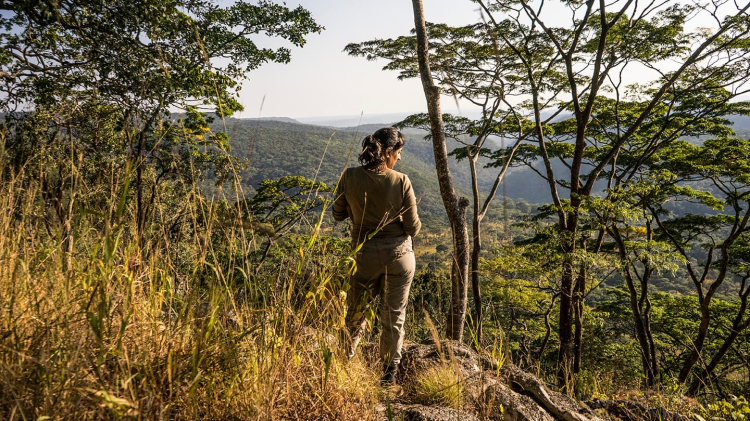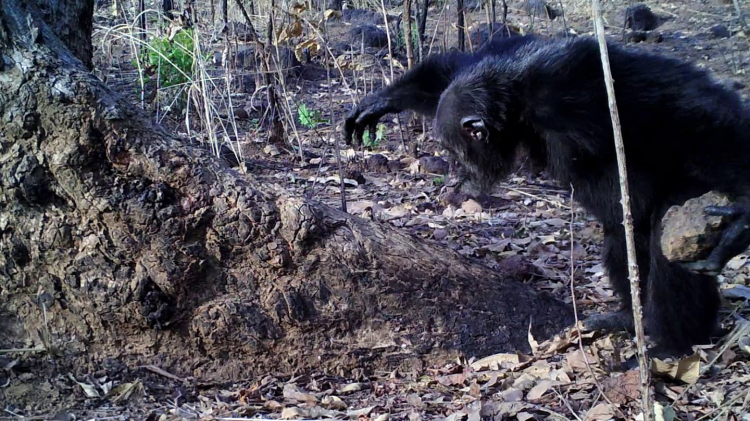As a child, Ammie Kalan watched David Attenborough visit Dian Fossey's mountain gorilla research site on the TV show "Life on Earth." She was fascinated.
When Kalan's Grade Five class then did a science section on endangered species, including mountain gorillas, it must have seemed to the 10-year-old like destiny.
But at a Wildlife Conservation Society field site in the Republic of Congo when she was a graduate student, chimpanzees knuckled aside gorillas in her academic affections.
"The site was very beautiful, remote and diverse," she says. "The animals were nesting close by and in the evening I could hear silverback gorillas hooting and chest-beating, chimps pant-hooting and screaming. In the morning, as I watched the chimps wake up, a young male was sitting in a tree, eating a piece of fruit and watching me watch him. I thought, What are you thinking as you look at us?'"
She has been trying to figure that out ever since.
A field-based primatologist, and one of only three great ape experts in Canada, anthropology assistant professor Kalan runs the Great Ape Behaviour Lab at UVic. She investigates the behavioural flexibility of wild great apes and other primates as they navigate their complex social and ecological environments. Her particular interest is variation in communication, tool use and culture.

Ammie Kalan: field-based primatologist, and one of only three great ape behavioural experts in Canada
Sticks and stones
The work that has captured the public's attention recently is Kalan's finding that chimpanzees throw stones at trees not in a fit of pique, and not just any trees.
"There's something communicative about the sound of the stones hitting the wood," Kalan says. "It's always the same trees, and not just any species of tree."
Often, the chimps vocalize as they throw, which contributes to the activity's use for long-distance announcements, potentially coordinating their movements to find food or each other.
Chimp accumulative stone throwing is unique in the animal world, rarely do you observe stone tool-use in the communication context."
Ammie Kalan
Kalan and her GAB Lab students currently investigate the spatial distribution of these accumulative stone throwing trees and their associated features. They will be heading to Guinea-Bissau next year for field work funded by a SSHRC Insight Development Grant.
And chimpanzees do more with rocks than just toss them. For millennia, they've also been using them as hammers and anvils to get access to food. Kalan is an early member of the field of primate archaeology, exploring primate tool-use or -production data. Evidence of chimpanzee stone technology in West Africa and capuchin tool use in Brazil dates back thousands of years. Primatologists like Kalan and archaeologists are keen to use stone tool use behaviours in primates to better inform models for the emergence of hominin stone technology.

A still from camera-trap footage showing a chimpanzee using a rock as a tool. Camera-trap technology has helped revolutionize the way scientists can study great ape behaviour.
At the movies
Since her days as a PhD student and then post-doctoral fellow at the Max Planck Institute for Evolutionary Anthropology, Kalan has been a member of the innovative Pan Africa Programme: the Cultured Chimpanzee, which set up more than 50 temporary research sites to collect data over ten years.
"PanAf," she says, "helped revolutionize the way we study wild chimpanzee behaviour and cultural diversity. Using videos rather than still photos you obtain recordings of dynamic behaviours that would be difficult to observe otherwise."
Her specialty is the behavioural data that is still coming from that program and cross-site analyses, which led to the first Science publication from the PanAf that documented the reduced behavioural and cultural diversity of chimpanzees in places where human impact is high. She followed that with a Nature Communications paper in which she examined the ecological factors, both past and present, that influence chimpanzee behavioural and cultural diversity.
Camera-trap video data allows the scientists to see not only that the animals were present at a site, but how they acted and responded in real time. In 2019, Kalan published "Novelty response of wild African apes to camera-traps" in Current Biology, describing how bonobos and gorillas showed a stronger impulse to look at the cameras compared to chimpanzees, and that young apes looked at the cameras longer than older animals.
As Scientific Moderator of the long-running Chimp&See project, she and thousands of volunteers around the world view the videos that come from PanAf cameras. By tagging clips with species and special behaviours, the community scientists help Kalan winnow the footage down to her area of interest. Right now, she's examining the predator-prey interactions between leopards and chimps.
Broad spectrum science
"Detailed research on both vocal and gestural communication in wild great apes shows a more nuanced and variable repertoire than once assumed," Kalan and her co-authors write in "What we know and don't know about great ape cultural communication," among the top 10 most downloaded papers of 2023 in the American Journal of Primatology. "We discuss the relevance of great ape cultural communication and its potential for illustrating evolutionary continuity for human-like cultural attributes, namely cumulative culture and symbolism."
"Collective action in wild chimpanzees provides further insight into the evolution of cooperative ritual behavior" in Religion, Brain and Behaviour Kalan comments that chimpanzee communities spend time and energy collectively defending and patrolling their territories with unique sets of behaviours, potentially used to pursue group goals and identity much as human rituals have been proposed to do.
She's also published in Primates, Nature Human Behaviour and Ecological Informatics, and these are just a few of her quite prolific outputs, including two Science articles so far this year alone: "Saving the cultural legacy of wild animals" describes the threats of biodiversity loss to maintaining cultural behaviours in primates; and "Local genetic adaptation to habitat in wild chimpanzees," used fecal DNA to illuminate whether and how chimps adapt to changes in their habitats.
"By publishing in a range of journals and books," she says, "the work reaches a much broader scientific audience and facilitates interdisciplinary exchange. It also stimulates my curiosity, pushing the boundaries of the types of questions I can ask and research. Also as a scientist, interacting and developing collegial relationships with scientists around the world is incredibly rewarding. They provide a constant source of inspiration and motivation."












